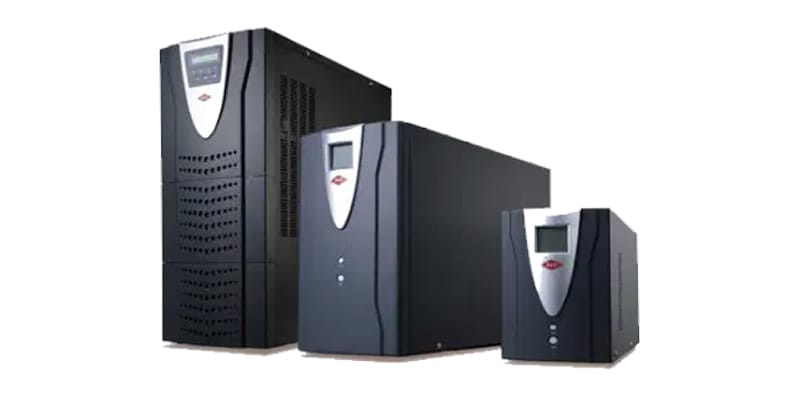- Home
- About us
- Products
- Dealer Enquiry
- Contact Us
- 044 -2486 1994
- +91 99623 98222
- sales@nantech.in
- REQUEST A QUOTE

In today's infrastructure landscape, Uninterruptible Power Supply (UPS) systems safeguard operations by delivering backup power during outages.
Modular UPS and conventional UPS represent two distinct methodologies for achieving this. Unlike traditional systems, modular UPS allows capacity adjustments via scalable modules, while conventional UPS architectures rely on fixed designs.
Choosing between the two UPS options directly impacts:
Both systems address unique market needs, with modular UPS excelling in dynamic environments and conventional UPS suiting smaller installations.
Understanding these differences is crucial for making informed decisions. Nantech, a leading provider of UPS in Chennai, offers comprehensive solutions for all your UPS needs.
Ready to dive deeper? Let's dissect the structural distinctions between these power solutions in this section.
Modular UPS systems employ individual, hot-swappable power modules, enabling seamless scalability while maintaining operational continuity. This architecture allows users to add or replace hot-swappable components without disrupting power flows.
Conventional UPS systems, in contrast, function as monolithic units with fixed capacities that lack inherent redundancy. Their central power paths create single points of failure, demanding complete shutdowns for maintenance procedures, such as rectifier or inverter replacements.
Also Read: Uncovering the Game-Changing Benefits of Modular UPS Systems
The core components of modular UPS include:
The core components of conventional UPS include:
With the fundamental structural differences between modular and conventional UPS architectures clarified, let’s next analyse their differences in operational adaptability in fluctuating power scenarios and scalability.
Modular UPS technology allows operators to seamlessly expand capacity through additional power modules. This scalability eliminates wasteful overprovisioning while aligning costs to actual load demands. Contrariwise, conventional UPS’s rigid infrastructure presents inherent bottlenecks. Their static capacities force purchasers to overspend on unused capacity early, while upgrades mandate costly downtime for complete unit swaps.
Furthermore, modular UPS’s compact design addresses critical space constraints in data centres. They vertically integrate components—enabling efficient deployment in infrastructure-cramped environments—whereas conventional UPS models demand dedicated floor space.
With their ability to scale and optimise space usage, modular UPS systems’ advantages in adaptability and flexibility become undeniable.
Modular UPS designs offer built-in N+1 redundancy: if one power module fails, others seamlessly compensate while maintaining full load capacity. This self-healing capability keeps facilities operational even during partial subsystem failures.
Conventional UPS systems, on the other hand, follow a riskier paradigm. Some incorporate basic redundancy measures, but critical component failures often precipitate complete shutdowns. Why does this matter? Conventional solutions require external backups like diesel generators, introducing unnecessary complexity and higher lifecycle costs for equivalent protection.
While conventional systems demand large capital investments and cumbersome backup layers, modular approaches deliver intelligent redundancy. Uptime optimisation here translates directly to business continuity assurance for data centres and critical infrastructure.
In mission-critical environments, operational continuity hinges on efficient maintenance protocols. Modular UPS systems redefine this benchmark through inherent serviceability advantages. With hot-swappable modules, engineers seamlessly remove/replace failed components mid-operation, eradicating downtime during repairs. Contrast this with conventional UPS maintenance, which often necessitates full shutdowns.
When comparing “modular UPS vs. conventional UPS” solutions, the ability to perform component-level upgrades extends equipment lifespan while reducing waste—critical factors for ESG-driven infrastructure strategies. As power requirements grow increasingly dynamic, aligning UPS architectures with operational priorities becomes essential for risk management.
Ultimately, deciding between the two UPS solutions—conventional UPS vs. modular UPS—hinges on your operational priorities, projected growth scale, and tolerance for infrastructure risk. Small business owners requiring scalable solutions thrive with adaptable modular UPS platforms, while those prioritising immediate cost reductions better suit static conventional UPS installations.
What's the golden rule? Conduct a comprehensive needs analysis with technical consultants before investing. At Nantech Power Systems Pvt. Ltd, Chennai, we translate your unique demands into durable infrastructure roadmaps. Our certified UPS engineers can help you navigate this decision with lifecycle costing models tailored to your infrastructure.
Contact us today to determine which UPS system is right for your business!
The UPS Rental Checklist
Know How To Buy The Right UPS!
Uncovering the Game-Changing Benefits of Modular UPS Systems
Thanks To UPS Manufacturers In Chennai Your Gadgets Are Safe!
Why Is It A Must To Invest In UPS or Inverter in Chennai?
Modular UPS Versus Conventional UPS: Differences Decoded
Uncovering the Game-Changing Benefits of Modular UPS Systems
Maximising Inverter Battery Performance: Key Factors to Consider
Role of UPS Systems in Critical Industries
Tamil Nadu Solar Power Subsidies: Everything You Need to Know
On-Grid vs. Off-Grid Solar Systems: The Ultimate Decision Guide